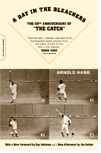 FATHERS
READING BOOKS WITH SONS FATHERS
READING BOOKS WITH SONS
Books matter. Baseball fans know
that reading helps us to draw this crazy sport
even closer to our hearts. We get to understand
each season better by reading all the essays and
numbers-crunching in an average copy of The
Hardball Times or Baseball
Prospectus. We get caught up in a pennant
race whose outcome we know and which was played
years ago, simply by reading. History unfolds
before us every nine innings of a current game
because baseball fans, more than any other sports
enthusiasts, read, read, read. That's a wonderful
thing, and we know it.
My Dad and I shared a passion for
reading. We'd often talk over the phone, comparing
titles we'd enjoyed, and favorite authors, from
Kurt Vonnegut to Paul Theroux to Raymond Chandler
to Jack Kerouac. I'd devour, say, Vonnegut's Slapstick,
in this case simply because he'd enjoyed it, and
I woudl see it with two sets of eyes: my own,
and my father's. We'd discuss it later, often
disagreeing, sometimes arguing. But what we came
away with was a shared experience between ourselves,
and between the reader and the author, and I loved
these conversations. The books were so much more
alive in this way.
My Dad passed away this summer,
after a bout with lung cancer and a severe stroke.
Unlike most baseball fans, I didn't have a baseball
connection with my Pop. There is none of the proverbial
"fathers playing catch with sons", though
he made it to most of my Little League games and
suffered through a Detroit Tigers contest in the
late 70s. When the Tigers went to the World Series
in '06, he wasn't someone I called frantically
when they threw the damn thing, almost literally,
away. I wish he'd loved baseball as I did, but
he didn't and that's that.
However, before he died he and I
shared two baseball books: the one I wrote and
Arnold Hano's A Day in the Bleachers.
After plowing through The End
of Baseball (which he loved, I'm proud to
report), he had asked me to find another great
baseball book for him to read. He wanted to understand
just what it was I liked about the game. I suppose
I could have handed over Veeck As In Wreck,
which influenced my novel, but that one, as much
as I love it, doesn't translate well to people
who don't give a hoot about baseball. So I chose
A Day in the Bleachers because it really
is the one title I would recommend to anyone,
male or female, love the game or hate it.
Well, Dad didn't love baseball but
he loved Hano's book. A Day in the Bleachers,
for those of you not in the know, captures one
day, one game, with such loving detail you can
almost smell the stale beer on the concrete floor
of the Polo Grounds. Arnold Hano observed Game
One of the 1954 World Series, between his beloved
Giants and the Cleveland Indians, and he didn't
leave anything out: the wonder of a well-played
game, the thrill of shouting with thousands of
other people, the often grubby and annoying manner
in which crowds comport themselves, and the author's
own, often curmudgeonly, opinions on everything.
I swear that if I wanted to recruit nonbelievers,
I'd hand out A Day in the Bleachers the
way Christians hand out New Testaments.
After reading A Day in the Bleachers,
Dad said that this was a "strange little
book", and that he enjoyed its many oddities.
Hano avoids most, if not all of the usual clichés,
and Dad and I both could relate to the author's
closing summary of that afternoon—that it
made him (Hano), "wonderfully, savagely happy".
Who hasn't felt that way about something joyous?
It's a small thing, reading a book
with someone you love. Reading Hano's tiny masterpiece
is one of many miniscule events in the forty year
relationship Dad and I shared, but like the bricks
that make the Great Wall of China, it all adds
up. You read a book, share it with someone, and
it takes on new life. It enriches your relationship,
and your understanding of said book. And later,
when that person is gone, it becomes even more
poignant. I now read A Day in the Bleachers
and think to myself that my father finally got
what I loved about baseball, and that he was transported,
as I was, to the Polo Grounds to see Willy Mays'
famous catch. ("The way he wrote it,"
Dad said, "even I could tell that was some
catch.")
The only point to this seemingly
pointless essay, then, is this: read. And read
with someone you care about deeply. I guarantee
that whatever book you choose will be a favorite
for the rest of your life. —Peter
Schilling

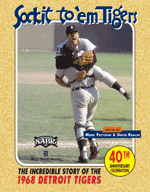 THE
CONVERGENCE THE
CONVERGENCE
As we all know, a baseball team
is an amalgamation of many talents. Pitchers,
catchers, infielders, outfielders, from the clubhouse
guy who picks up towels to the owner sitting in
his glass-walled luxury suite, every team is made
up of dozens of individuals. And for every given
season, these people converge to create something
wonderful.
Sock
It To 'Em Tigers is a collection
of essays about the 1968 Detroit Tigers. But this
is a poor way to describe this amazing book, an
essential title in any Tigers' fan's library (though
I would argue it's great for any baseball fan.)
Really, it is a story about the team as a living
thing. The '68 Tigers are probably the most beloved
sports club in Michigan history. (Perhaps the
'35 Tigers were as beloved, but their fans have
since died off.) Here we get to see just what
made up the organism that was the '68 Tigers—from
"Huck Finn-like figure" John Matchick,
who pinch hit for the Bengals, on up to Al Kaline
and John Fetzer, owner of the club. Each player,
no matter how insignificant, merits a detailed
essay that takes us from their upbringing in some
small hamlet or large burg, to their moment in
the sun with the World Champion Tigers, and then
follows them as their careers waned, and they
found themselves in their sunset years. Or they
died.
In fifty-one essays, the members
of the Mayo Smith Society (the Tigers fan club),
in conjunction with the Society
for American Baseball Research, capture the
Detroit Tigers better than any book I've ever
read. There's some joyous passages, like Mickey
Lolich ("the beer-drinker's hero"),
pitcher Pat Dobson (described as "perhaps
the funniest man who ever wore a baseball uniform"),
and catcher Bill Freehand, who I believe should
be in the Hall of Fame.
Some essays are touched with tragedy.
We see handsome Don McMahon, who was only with
the Tigers for twenty games (arriving halfway
through the season in a trade with the White Sox),
who bounced from team to team, found a job as
a coach and scout, but died at 57 of a heart attack
(he was buried with a baseball in his hand.) We
see Stormin' Norman Cash, Tigers slugger, fighting
alcoholism, strokes, and finally drowning after
slipping off a wet pier. And of course, there's
Denny McLain, whose tragic story probably doesn't
need to be summarized here.
Sock It To 'Em Tigers includes
great essays about Tiger Stadium, the broadcasters,
owners, coaches, and it's the same for every one—from
their humble beginnings to their rise with the
Tigers and in some cases to equally humble endings.
Sock It To 'Em should serve as a model
for any serious fan organization seeking to write
a book about their favorite team. I absolutely
loved this book, one that makes the 1968 Detroit
Tigers come joyously, fitfully alive.—Peter
Schilling

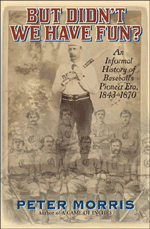 FROM
TOWN BALL TO BASEBALL FROM
TOWN BALL TO BASEBALL
Baseball's childhood and young
adulthood have rarely been put into form so accessible
as Peter Morris's But
Didn't We Have Fun: An Informal History
of Baseball's Pioneer Era, 1843-1870.
It's an achievement because that childhood
and young adulthood weren't quite as simple
as mythology and romance have had it to be, and
making it accessible while making it concurrently
charming would be an arduous job for any skilled
and patient historian.
Morris knows that well, considering
how many histories of our game "barely mention
the nineteenth century," beyond the Knickerbockers
of New York in the 1840s, the Cincinnati Red Stockings
of 1869, and the still-persistent (if long debunked)
Doubleday myth. "The unfortunate result,"
Morris writes, "is that the story of the
first generation of Americans to embrace a game
recognisable as baseball has never been told."
Not, at least, with the anecdotal embrace and
unclincial affection Morris deploys.
Remember when the saying was "Washington:
First in war, first in peace, and last in the
American League?" Once upon a time, the
saying could have been, "Washington: First
in war, first in peace, and first to play ball
of the Alleghenies." Two years before the
Red Stockings went professional and undefeated,
the Washington Nationals of 1867, barnstormed
Chicago, Cincinnati, Columbus, Louisville, Indianapolis,
and St. Louis, and received rave reviews no matter
that they were owned by the government.
Specifically, the Treasury Department.
One of its grand high exhausted mystic roosters
happened to be the team president. But thank the
players for cauterising that connection, Morris
writes: "Because the Nationals earned a
reputation for gentlemanly conduct and being ambassadors
for the sport, few of their contemporaries questioned
their methods of player acquisition. But such
practices created huge inequities between cities,
and these disparities had a corrosive effect on
the game." And you thought the arguments
about the haves versus the have-nots began in
the Steinbrenner era.
Not that the regional versions of
the game went down without a fight, Morris writes,
citing a Cincinnati writer who said it "required
time, and much persuasion, to accomplish the revolution.
The old love fought hard against invasion, but
the new love, by force of reason and persistency,
won its way gradually into the town-ball sport,
and finally superceded the old game entirely."
And, in the case of Cincinnati,
forged a legend as troublesome as it was titillating.
The good news: Led by a gentleman (in every sense
of the word) named Harry Wright, himself a refugee
from the Knicks and the Gothams, the Red Stockings
became in 1869 baseball's only known undefeated
professional team. "[H]e showed the world,"
Morris writes, "that professional baseball
could be played with class and dignity."
And, scouted properly, it could put on the field
a team of unstoppable players, not to mention
introducing the knicker style of uniform pants
that stayed a baseball standard for over a century.
The bad news: The Red Stockings
suffered extra-inning losses in Brooklyn in 1870,
shocking their fans but not anyone who saw other
clubs taking their hint and upgrading their talent.
Then came other losses and, concurrently, a little,
shall we say, ungentlemanly off-field behaviour,
such as infielder Charley Sweasy strolling into
a tavern in his Red Stockings uniform. As striking
as that must seem to the 21st century fan—which
has seen athletes caught in far seamier scenarios
and acts, the Red Stockings' image as invincible
gentlemen was pricked firmly enough that their
parent, the Cincinnati Base Ball Club, sent the
team to bed without its supper. The Club chose
not to field a professional squad in 1871.
The Cincinnati Commercial was
not amused. "[W]e are to get enthusiastic
over gratuitous amateurs who, if they turn out
handsomely, will remove to some other city and
get salaries."
You lose count of how many generations
hence have thought the game they loved was going
to be ruined by the next generation's "professionalism,"
even as you lose count of how many generations
swear they've restored the game to the way it
ought to be, after wresting it from those
dolts who nearly buried it alive with their experiments
and monstrosities.
Try this one, speaking of, ahem,
a more resilient ball: I have always been
a fellow who liked to see efficiency rewarded.
If a pitcher pitched a swell game, I wanted to
see him win it. So it kind of sickens me to watch
a typical pastime of today in which a good pitcher,
after an hour and fifty minutes of deserved mastery
of his opponents, can suddenly be made to look
like a bum by four or five great sluggers who
couldn't have held a job as bat boy on the Niles
High School srcubs.
Shows you what Ring Lardner—who
wrote those words in "Br'er Rabbit
Ball," a 1930 essay—didn't know
about his own beloved game's history. It
might have been delicious if he could have lived
to read Morris's reminder. Chicks (and other
bi-peds) dug the long ball long before Babe Ruth
gestated in the womb, never mind before Tom Glavine
and Greg Maddux offered that grave observation
in the fever of a television commercial. There
came a lively ball in the 1860s, rubber-cored
and able to travel into the next county when hit
squarely enough.
Players loved it, such as the unknown
Pennsylvania player who said, "We used the
lively ball and when it left the bat after being
hit square, came at one as though shot from a
cannon . . . a good batsman could drive the ball
almost to kingdom come." Those watching
the games were likewise enchanted, Morris writes.
"[B]efore long almost every town had its
legendary stories of long-ball hitters. In Boston
old-timers related stories about a brawny lad
‘who used bats four feet long, and his score
averaged more than ten percent of home runs. He
struck a ball considerable over the vane of Park
Avenue Church, 225 feet up, and would repeatedly
send a ball to that height without moving from
his position."
A somewhat mythological Brooklyn
ballplayer, Boaz Pike, was said by the old Brooklyn
Eagle to have "struck the longest ball
yet battled on the field, not less, perhaps, than
600 feet straight ahead." Albert H. Pattengill
died as a distinguished University of Michigan
professor of Greek, but his 1906 obituaries highlighted
students revering "a home run [batted] once
from a point 100 feet south of North University
avenue, so that the sphere landed on the skylight
on top of the old medical building."
Pitching before the long ball was
nothing more than tossing something up for a batter
to hit if he liked it. Then came Jim Creighton,
an apparent submariner, with more than a few ways
and movements by which to deliver his balls, and
perhaps a normal human aversion to public humiliation.
Others came to follow. That in turn begat allowing
the umpires to call balls and strikes, the better
to keep batters (who'd been allowed previously
to wait for one he felt comfortable enough to
drive) from wearing down a pitcher beyond reason.
Morris's liberal deployment of contemporary
accounts and records is effective for its atmospheric
and historical patina, even if he acknowledges
the flaws in some of those accounts. Along with
David Block (Baseball Before We Knew It,
which traces somewhat more clinically the roots
prior to the era Morris examines), he's restored
a huge repository of baseball's history. But he's
also reminded us that, inevitable though it might
have been, professionalism doesn't always destroy
what it refines or enrichens, in hand with an
unspoken but profound reminder that, if we sour
when we see players or teams managing to play
seriously without forgetting to have fun, the
fault is in ourselves, not in our stars.—Jeff
Kallman

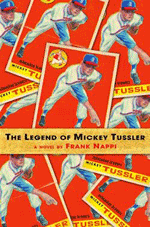 A
NOVEL TO SHARE ON A SUMMER'S DAY A
NOVEL TO SHARE ON A SUMMER'S DAY
If you share your world with a young
adult, there is perhaps no better novel in recent
years to read together than Frank Nappi's The
Legend of Mickey Tussler. The
story of a young man fighting autism who lands
a spot on the Milwaukee Brewers team in 1948,
Tussler is crack read. This is not specifically
a young adult novel, but like books with a very
straightforward plot and a handle on people, this
one will win over kids and parents alike. Read
it together one summer, between ball games and
on a family vacation.
The Legend of Mickey Tussler
is the story of world-weary scout Arthur Murphy.
Murph, as he's known, is trying desperately to
dig up a great ballplayer, and wondering if his
time with this often cruel sport is nearing an
end. He discovers the eponymous boy pitching apples
at a barrel and can't believe his eyes—the
kid is good. Unfortunately, the kid comes with
both a blessing and a curse. The blessing is a
wonderful mother by the name of Molly, and the
curse is personified by an abusive father named
Clarence. Clarence isn't interested in his "retard"
son playing ball, until Murph waves some dollar
bills in his face, and the boy is off to the Brewers.
What emerges is a story that resembles
The Natural, but with a pair of heroes
we can relate to and root for. It is an ideal
novel for a young person to wrestle with together
with a happy parent. Mickey Tussler has
some surprisingly dark turns—which readers
of Mudville know I dig—and its vague ending
is perfect, leaving one to imagine where Mickey
and Murph and Molly will end up next. The
Legend of Mickey Tussler will have you pondering
love, bigotry, and best of all baseball. Who could
ask for more?—Peter Schilling

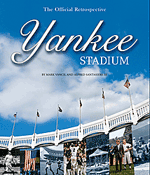 IN
BRIEF IN
BRIEF
When you're going to make a coffee
table book about a beloved stadium that's facing
the wrecking ball, the standard remains The
Corner, The
Detroit Free Press' wonderful look at Tiger
Stadium. That book is filled with evocative photographs,
beautiful reminiscences, and a number of edgy
observations about my favorite stadium. It's truly
warts and all. Most of these retrospectives are
as dull as your average magazine from the Hall
of Fame. Yankee
Stadium: The Official Retrospective
(wonderful title, that) by Mark Vancil and Alfred
Santasiere III falls, surprisingly, somewhere
in-between. It has great photos and some dynamite
essays interspersed between some kooky or outright
dull stories. And why is Dan Quayle one of those
folks waxing rhapsodic about Yankee Stadium? The
Indiana Senator and V.P. isn't from New York,
and probably only attended a few games over the
years. My guess is he's a pal of Steinbrenner's,
but still. For an "official" book on
the subject, Yankee Stadium: The Official
Retrospective is a surprise, and
though not as great as The Corner (and
that greatness has never been matched anyway)
it is well worth buying for the Yankee fan you
know...On the other hand, Baseball's
Greatest Hit: The Story of Take Me Out to the
Ball Game is no surprise. I
gathered it was going to be great, and great it
is. Frankly, I had no clue that a big book about
"Take Me Out to the Ball Game" could
be so interesting, but there you go.Virtually
every aspect is covered here, from the history
of the song, to parodies of the tune, who recorded
it, when, and everything in between. Each essay
is a joy to read, it's rich with archival photographs
and comes with a CD. My favorite part: "Get
Up, Stand Up: How the Seventh Inning Stretch is
Observed Today". Around the leagues we go,
with summaries of every team's tradition. A number
of teams, like the Rangers and Giants, don't have
any fun, as fans sing to a recorded version of
the song. Oddly enough, The Rays, notorious for
having a mediocre fan base (as evidenced by small
crowds throughout this amazing season) have a
live organ rendition of baseball's national anthem
and encourage fans to replace "home team"
with "Rays." Which is what every team
should do, in my opinion... I had the great privilege
of having a reading this summer at Magers &
Quinn booksellers in Minneapolis. With me were
two fellow writers, whose books are treasures.
Daniel R. Levitt's Ed
Barrow: The Bulldog Who Built the Yankees First
Dynasty is an in-depth biography
of a man who has been woefully neglected by baseball
writers and Tom Swift's Chief
Bender's Burden is an exacting
look at the difficulties Mr. Bender faced, being
a Native American from Minnesota and facing all
sorts of trials on the field because of this (it's
a surprisingly dark and beautifully written.)
Don't miss either one... I loved 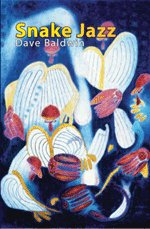 Dave
Baldwin's quirky little memoir Snake
Jazz. Baldwin was a pitcher
for the Senators, Brewers, and White Sox who struggled
after hurting his arm in high school. This could
be your typical memoir, but Dave avoids the usual
cliches, and espouses a philosophy he's lived
by his whole life, something his father once told
him: "If you work hard enough, and thoughtfully
enough, you can succeed at anything." (And
I like that both the working and the thinking
are emphasized.) And so Dave Baldwin pursued a
career in baseball and genetics research and engineering
and painting and now writing. Along the way he
met a number of interesting people (including
the famously foul-mouthed Ted Williams, Dave's
manager with the Senators) and situations (like
having a thief steal his underwear.) As Scientific
American once said "Dave Baldwin is
surely the only person to publish in the Proceedings
of the Entomological Society of Washington
and to pitch for that town's team." Classic...
Dave Zirin's A
People's History of Sports in the United States
is a book that was too long in coming. Part of
Howard Zinn's "People's History" series
(he wrote the great People's History of the
United States), the book is an essential
part of any sports fan's library. Zirin probes
the underside of sports, namely those athletes
who chose to use their status to fight against
the powers that be in this world. Though this
is not baseball-focuses (and features Muhammed
Ali on the cover) it is a great book, insightful,
thought-provoking, and irritating: you really
want to get up and fight yourself after reading
it... How does Rob Neyer do it? Year after year
he comes out with new "Big Books", and
each one is delightful. His newest is Rob
Neyer's Big Book of Baseball Legends,
and its unlike other SABR-type bubble-bursting
tomes, in that it shows a great respect for the
men and women who are perpetuating these (usually)
incorrect tales. We have the usual suspects, such
as Babe Ruth's called shot, but there are a number
of stories debunked that I hadn't even heard of,
like Clarence "Climax" Blethen, who
had his false teeth in a back pocket and "bit
himself" when he had to slide on a stolen
base attempt. But my favorite is a touching tribute
to the great Lawrence
Ritter. Here, Neyer "debunks" Ritter's
claim that what appeared in his classic oral history
The Glory of Their Times was straight
from the horse's mouth. Neyer shows us instead
that Ritter was the consummate gentleman, trying
to give credit to his subjects, but that he was
really a master at editing and slightly altering
the tales to make them infinitely more readable.
Here, we see that Neyer, too, is a gentleman,
a great researcher, and the creator of classic
baseball books.—Peter Schilling Dave
Baldwin's quirky little memoir Snake
Jazz. Baldwin was a pitcher
for the Senators, Brewers, and White Sox who struggled
after hurting his arm in high school. This could
be your typical memoir, but Dave avoids the usual
cliches, and espouses a philosophy he's lived
by his whole life, something his father once told
him: "If you work hard enough, and thoughtfully
enough, you can succeed at anything." (And
I like that both the working and the thinking
are emphasized.) And so Dave Baldwin pursued a
career in baseball and genetics research and engineering
and painting and now writing. Along the way he
met a number of interesting people (including
the famously foul-mouthed Ted Williams, Dave's
manager with the Senators) and situations (like
having a thief steal his underwear.) As Scientific
American once said "Dave Baldwin is
surely the only person to publish in the Proceedings
of the Entomological Society of Washington
and to pitch for that town's team." Classic...
Dave Zirin's A
People's History of Sports in the United States
is a book that was too long in coming. Part of
Howard Zinn's "People's History" series
(he wrote the great People's History of the
United States), the book is an essential
part of any sports fan's library. Zirin probes
the underside of sports, namely those athletes
who chose to use their status to fight against
the powers that be in this world. Though this
is not baseball-focuses (and features Muhammed
Ali on the cover) it is a great book, insightful,
thought-provoking, and irritating: you really
want to get up and fight yourself after reading
it... How does Rob Neyer do it? Year after year
he comes out with new "Big Books", and
each one is delightful. His newest is Rob
Neyer's Big Book of Baseball Legends,
and its unlike other SABR-type bubble-bursting
tomes, in that it shows a great respect for the
men and women who are perpetuating these (usually)
incorrect tales. We have the usual suspects, such
as Babe Ruth's called shot, but there are a number
of stories debunked that I hadn't even heard of,
like Clarence "Climax" Blethen, who
had his false teeth in a back pocket and "bit
himself" when he had to slide on a stolen
base attempt. But my favorite is a touching tribute
to the great Lawrence
Ritter. Here, Neyer "debunks" Ritter's
claim that what appeared in his classic oral history
The Glory of Their Times was straight
from the horse's mouth. Neyer shows us instead
that Ritter was the consummate gentleman, trying
to give credit to his subjects, but that he was
really a master at editing and slightly altering
the tales to make them infinitely more readable.
Here, we see that Neyer, too, is a gentleman,
a great researcher, and the creator of classic
baseball books.—Peter Schilling

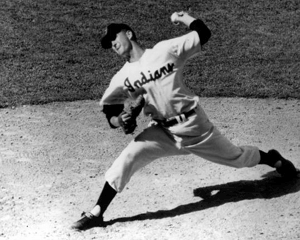 HERB
SCORE, RIP HERB
SCORE, RIP
Once a Hall of Fame-bound pitcher,
Herb Score became a Cleveland Indians broadcast
icon... and a city's friend. He never rued his
horrible fortune, whether it refers to getting
hit in the face by a screaming line drive; or,
getting hit in his car, the night after his induction
into the Broadcasters'
Hall of Fame, to trigger a painful series
of debilitating illnesses that left him wheelchair
bound until his death at 75 on Veterans Day.
That's because Herb Score really
didn't believe his fortune was so horrible, after
all. He had all he could do to convince everyone
else of that, however.
He also didn't really believe that
what might have looked to become a Cooperstown
pitching career was deadened once and for all
on May 5, 1957, the date which still lives in
Cleveland infamy, when Gil McDougald's liner blasted
the lefthander's right cheekbone, his nose, and
his right eyelid, while blowing his right eye
up slightly and leaving him in a bleeding heap
at the front of the mound from which he'd dominated
the American League his first two seasons.
"When Score was taken off the
field on a stretcher," McDougald told New
York Times columnist Ira Berkow almost four
decades later, "I was sick to my stomach.
I didn't want to play anymore. [Yankee manager
Casey Stengel] said, 'You're getting paid to play,'
and while that seems harsh, it was right. It was
like getting right back on a horse after you've
been thrown.
"But I said that if Herb loses
his eye, I'm quitting baseball."
Score spent the rest of 1957 recuperating
(his vision eventually restored to 20/20), then
returned to the Indians to try picking up where
he left off. Most of everyone else forgot what
really came to sink his pitching career: he blew
an elbow tendon pitching against the Washington
Senators in 1958, on a cold, damp night, following
ten days' inactivity thanks to a pair of rainouts
that delayed a starting assignment.
He started 1959 feeling healthy,
but hoping to avoid any similar elbow injury he
shifted his pitching motion just enough. As he'd
come to tell Cleveland Plain-Dealer writer
Terry Pluto, in 1994, for his book, The Curse
of Rocky Colavito, "I overcompensated
for it and ended up with some bad habits."
After continuing low spells in
San Diego and Indianapolis convinced him, Score
retired before the 1964 season.
"People asked me why I went
to the minors to pitch," he would tell Pluto.
"I still believed that my arm might come
back. I was only thirty. I didn't want to be sitting
somewhere when I was sixty and wondering, 'What
if I had pitched one more year, would I have found
it?' Now I know. I have no doubts. I tried everything,
and I pitched until they pretty much tore the
uniform off my back."
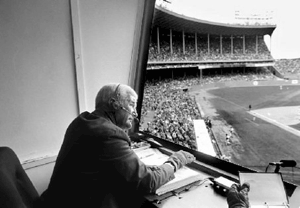 Score
moved to the broadcast booth and became even more
a Cleveland icon in front of a microphone than
he might have been on the mound. But until he
retired following the last game of the 1997 World
Series, enough people still wanted to talk about
his aborted pitching career, perhaps understandable
about a man Bob Feller believes might have become
Sandy Koufax before Sandy Koufax really became
Sandy Koufax. Score
moved to the broadcast booth and became even more
a Cleveland icon in front of a microphone than
he might have been on the mound. But until he
retired following the last game of the 1997 World
Series, enough people still wanted to talk about
his aborted pitching career, perhaps understandable
about a man Bob Feller believes might have become
Sandy Koufax before Sandy Koufax really became
Sandy Koufax.
Score preferred to talk about anything
but.
"In Milwaukee, I remember a
fan leaning into the radio booth and saying, 'Herb,
let me see your eye. Is it okay? How well do you
see?' I wonder how I'd handle a question like
that," said longtime Indians broadcaster
Nev Chandler. "But Herb was nice. He told
the guy that his vision was normal. Then he said,
'Nice to see you. Thanks for stopping by.' But
that's Herb. He is a man of no bitterness, no
regrets. He says that the game has been great
to him, so what does he have to complain about?"
He never blamed McDougald for a
thing. "I talked to Gil and told him it was
something that could happen to anyone," Score
would say. "It's just like a pitcher beaning
a hitter." He didn't mean it."
Score was as subdued and matter-of-fact
personally as he was on the air, though he was
good for the occasional Jerry Coleman-like malaprop.
(Swing and a miss, foul back to the screen was
a Score classic.) When Edgar Renteria ended the
1997 Series with a walkoff single off Charles
Nagy, normally a starter but brought in from the
bullpen, Score's call was just as simple and just
as classic.
Line drive, base hit, the game
is over, he told his listeners. By the end
of the coverage, Score was saying his own farewell.
And so that is the season for 1997. And there's
very little else we can say except to tell you
it's been a pleasure. I would like to thank all
the fans for their kindness over the years. You've
been very good to me. And we hope that whoever
sits in this chair next, you'll be as kind to
them as you have been to me.
"He was a mentor for me—a
sounding board," says current Indians broadcaster
Tom Hamilton, the son of Milo. "Outside of
my father, I know of no other man who gave me
better advice than Herb."
"There has to be some private
moment," longtime baseball executive and
Score friend Hank Peters once pondered, "when
he no doubt thinks back and wonders 'What if?'
But Herb is happy with his life. He enjoys his
work. There is nothing phony about him."
Call Score unlucky and Score would shake it off
the way many a hitter thought they'd have to spend
years shaking it off after another pounding strikeout.
While Lakeside Hospital took "a
call a minute" from anxious Indians fans
after he was carried off the mound, Score himself
managed to listen to the rest of the game on a
radio and to cheer when Colavito nudged in what
proved the game winner with a bases-loaded walk
in the bottom of the eighth.
Then he polished off a bowl of ice
cream to celebrate the win.
In the years before his death,
Score managed, one way or the other, to continue
making personal appearances now and then, always
leaving behind stories of his friendly nature
and his ability to make friends out of plain people
and powerful people on his own benign terms.
"Me? Unlucky?" Score told
Pluto, and you could sense the incredulity. "I
started with a great team in the Indians, and
played under a great manager in Al Lopez. Then
I went from the field to the broadcasting booth
at the age of thirty, and thirty years later I'm
still doing the games. If you ask me, that's not
unlucky. That's a guy who has been in the right
place at the right time."
That's a guy with a lot more vision
than you'd have found through either of his eyes.—Jeff
Kallman

|



